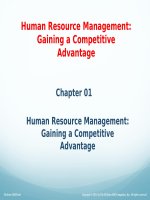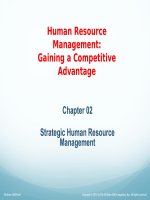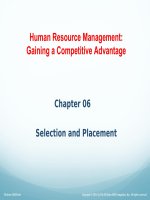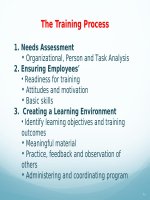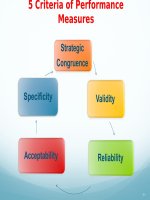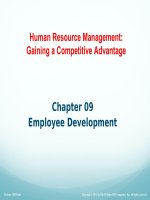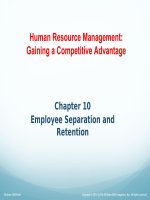Human resource management gaining a competitive advantage 9th edition noe test bank
Bạn đang xem bản rút gọn của tài liệu. Xem và tải ngay bản đầy đủ của tài liệu tại đây (457.84 KB, 95 trang )
Chapter 02
Strategic Human Resource Management
True / False Questions
1.
The goal of strategic management in an organization is to deploy and allocate resources in a way that
it provides the company with a competitive advantage.
True
2.
False
To be maximally effective, the human resource management function of a company must be isolated
from the company's strategic management process.
True
3.
Strategic planning groups decide on a strategic direction during the strategy implementation phase.
True
4.
False
Strategy implementation includes structuring an organization and allocating resources.
True
5.
False
False
In a two-way linkage, an organization is restricted from considering the human resource issues while
formulating their strategic plan.
True
6.
False
Untapped labor pools are an example of a strategic threat to an organization's operating
environment.
True
False
2-1
Copyright © 2015 McGraw-Hill Education. All rights reserved. No reproduction or distribution without the prior written consent of McGraw-Hill
Education.
7.
External analysis attempts to identify an organization's strategic opportunities and threats.
True
8.
False
Strategic choice describes the way an organization attempts to fulfill its mission and achieve its longterm goals.
True
9.
False
Job design addresses what tasks should be grouped into a particular job.
True
False
10. The strategy a company is pursuing does not have an impact on the types of employees that it seeks
to recruit and select.
True
False
11. Training refers to a planned effort to facilitate the learning of job-related knowledge, skills, and
behavior by employees.
True
False
12. Companies that are not diversified use objective measures of performance to evaluate managers.
True
False
13. Executives who have extensive knowledge of the behaviors that lead to effective performance tend to
focus on evaluating the objective performance results of their subordinate managers.
True
False
14. By tying pay to performance, a company can elicit specific activities and levels of performance from
employees.
True
False
2-2
Copyright © 2015 McGraw-Hill Education. All rights reserved. No reproduction or distribution without the prior written consent of McGraw-Hill
Education.
15. Concentration strategies require that an organization bring radical change to the current skills that
exist in the organization.
True
False
16. An overall cost leadership strategy is achieved primarily by offering unique product features.
True
False
17. Companies engaged in a cost strategy require employees to have reduced concern for quantity and a
short-term focus.
True
False
18. Companies engaged in cost strategies develop internally consistent pay systems with negligible pay
differentials between superiors and subordinates.
True
False
19. Employees in companies with a differentiation strategy need to have only a moderate concern for
quantity.
True
False
20. Differentiation companies will have compensation systems that are geared toward internal rather than
external equity.
True
False
21. Strategies emphasizing market share or operating costs are called "external growth" strategies.
True
False
22. Companies using concentration strategies attempt to focus on what they do best within their
established markets.
True
False
2-3
Copyright © 2015 McGraw-Hill Education. All rights reserved. No reproduction or distribution without the prior written consent of McGraw-Hill
Education.
23. Downsizing gives an organization the opportunity to change its culture.
True
False
24. Companies going through downsizing often develop compensation programs that tie an individual's
compensation to the company's success.
True
False
25. A learning organization constantly monitors its environment, assimilates information, makes decision,
and flexibly restructures itself to compete in an ever-changing environment.
True
False
Multiple Choice Questions
26. Which of the following is a physical resource that a company uses to compete with other companies?
A. Controlling system
B. Technology
C. Planning system
D. Employee skill
E. Experience of employees
27. A(n) _____ typically charts how a firm will create value for customers and how it will do so profitably.
A. design specification
B. business model
C. job characteristics model
D. administrative linkage
E. process architecture
2-4
Copyright © 2015 McGraw-Hill Education. All rights reserved. No reproduction or distribution without the prior written consent of McGraw-Hill
Education.
28. _____ costs are incurred regardless of the number of units produced.
A. Acquisition
B. Procurement
C. Fixed
D. Variable
E. Marginal
29. Which of the following statements is true of variable costs incurred by firms?
A. These costs are independent of the number of goods produced by firms.
B. The rent and interest paid by firms are examples of variable costs.
C. These costs are the difference between what firms charge for their products and the fixed costs of
the product.
D. These costs change directly with the units produced.
E. These costs refer to the total amount of margin made by a firm.
30. Which of the following is an example of a fixed cost?
A. Raw materials
B. Factory rent
C. Operating cost
D. Direct labor costs
E. Packaging costs
31. The _____ margin is calculated as the number of units sold times the contribution margin.
A. holding cost
B. gross
C. profit
D. fixed cost
E. overhead rate
2-5
Copyright © 2015 McGraw-Hill Education. All rights reserved. No reproduction or distribution without the prior written consent of McGraw-Hill
Education.
32. _____ refers to what is left after a firm pays its variable costs and fixed costs.
A. Contribution margin
B. Overhead cost
C. Profit
D. Variance
E. Holding cost
33. A _____ workforce describes the former workers to whom a firm still owes financial obligations.
A. contingent
B. consultant
C. temporary
D. legacy
E. contract
34. Jonathan retired from a large multinational automobile company last year. He receives health care
benefits as well as a pension from the company. At present, Jonathan falls under the category of a
_____.
A. contingent workforce
B. legacy workforce
C. temporary workforce
D. consultant workforce
E. contract workforce
2-6
Copyright © 2015 McGraw-Hill Education. All rights reserved. No reproduction or distribution without the prior written consent of McGraw-Hill
Education.
35. _____ is a process that primarily addresses the competitive challenges an organization faces.
A. Operational management
B. Transactional management
C. Management by objectives
D. Process mapping
E. Strategic management
36. When an organization develops integrated manufacturing systems such as advanced manufacturing
technology and just-in-time inventory control, it needs to assess the employee skills required to run
these systems and train them accordingly. These assessments and training programs intended to
enable an organization to achieve its goals fall under:
A. strategic human resource management.
B. the job characteristics model.
C. diversity management.
D. the employee stock ownership plan.
E. participative management.
37. During _____, the strategic planning groups decide on a strategic direction by defining the company's
mission and goals, its external opportunities and threats, and its internal strengths and weaknesses.
A. strategy implementation
B. task design
C. selection and training
D. strategy formulation
E. strategy evaluation
2-7
Copyright © 2015 McGraw-Hill Education. All rights reserved. No reproduction or distribution without the prior written consent of McGraw-Hill
Education.
38. Pluto Inc., a large manufacturer of desktops and laptops, has decided to enhance revenues by
expanding its product line. It has identified the tablet market as a possible market to expand, and has
identified Compco Inc. as a potential competitor. Pluto Inc. is currently in the _____ stage of the
strategic management process.
A. strategy formulation
B. strategy evaluation
C. strategy execution
D. strategy consultation
E. strategy implementation
39. Saturn Inc. is a large manufacturer of footwear and accessories. It has always lagged behind its closest
competitor Hexagon Inc. It plans to overtake Hexagon by leveraging its strength in women's footwear
and entering markets in the Mid-West that it had traditionally ignored. Saturn Inc. is in the _____
phase.
A. strategy implementation
B. strategy formulation
C. administrative linking
D. selecting and training
E. task designing
40. During the strategic implementation stage of the strategic management process, an organization:
A. decides on a strategic direction.
B. defines its mission and goals.
C. establishes external opportunities and threats.
D. ensures that it has skilled employees in place.
E. determines its internal strengths and weaknesses.
2-8
Copyright © 2015 McGraw-Hill Education. All rights reserved. No reproduction or distribution without the prior written consent of McGraw-Hill
Education.
41. Which of the following statements is true of a strategic implementation stage of the strategic
management process?
A. During this stage, an organization analyzes its strengths and weaknesses.
B. This is the first stage of the strategic management process, which is sequential in nature.
C. During this stage, an organization follows through on a strategy chosen in the strategy formulation
stage.
D. During this stage, an organization defines its mission and goals.
E. This stage is independent of the formulation stage in the strategic management process.
42. _____ component of the strategic management process consists of structuring the organization,
allocating resources, ensuring that the firm has skilled employees in place, and developing reward
systems that align employee behavior with the organization's strategic goals.
A. Task designing
B. Strategy implementation
C. Administrative linking
D. Strategy formulation
E. Operational implementation
43. The strategic management decision-making process usually takes place at a firm's highest levels, with
a firm's strategic planning group, which includes:
A. middle managers and directors.
B. the chief executive officer and supervisors.
C. the chief executive officer and the president.
D. accountants and supervisors.
E. the directors and labor union representatives.
2-9
Copyright © 2015 McGraw-Hill Education. All rights reserved. No reproduction or distribution without the prior written consent of McGraw-Hill
Education.
44. Which of the following is the lowest level of integration between the human resource management
function and the strategic management function?
A. Administrative linkage
B. Two-way linkage
C. Integrative linkage
D. Executive linkage
E. One-way linkage
45. Which of the following statements is true of the administrative linkage level between the human
resource management function and the strategic management function?
A. In this level, the Human Resource Management department is completely divorced from any
component of the strategic management process.
B. This level recognizes the importance of human resources in implementing the strategic plan.
C. In this level, the Human Resource Management designs systems and/or programs that implement
the strategic plan.
D. This level allows for consideration of human resource issues during the strategy formulation
process.
E. In this level, the Human Resource Management functions are built right into the strategy formulation
and implementation processes.
46. Which is the level of integration at which the human resource management primarily engages in dayto-day activities unrelated to the company's core business needs?
A. Administrative linkage
B. One-way linkage
C. Two-way linkage
D. Integrative linkage
E. Executive linkage
2-10
Copyright © 2015 McGraw-Hill Education. All rights reserved. No reproduction or distribution without the prior written consent of McGraw-Hill
Education.
47. In _____, a firm's strategic business planning function develops the strategic plan and then informs the
Human Resource Management function of the plan.
A. integrative linkage
B. executive linkage
C. two-way linkage
D. one-way linkage
E. administrative linkage
48. Which of the following is true of one-way linkage?
A. In this level, the human resource management executive has no time or opportunity to take a
strategic outlook toward human resource issues.
B. It precludes the company from considering human resource issues while formulating the strategic
plan.
C. In this level, the human resource management functions are built right into the strategy formulation
process.
D. In this level, the human resource management function is involved in both strategy formulation and
strategy implementation.
E. It lets the human resource management executive to give strategic planners information about the
company's human resource capabilities.
49. The one-way linkage level:
A. is the lowest level of integration.
B. restricts companies from considering human resource issues while formulating strategic plan.
C. is multifaceted, based on continuing rather than sequential interaction.
D. often leads to strategic plans that companies cannot successfully implement.
E. segregates the Human Resources Management department from other components of the strategic
management process.
2-11
Copyright © 2015 McGraw-Hill Education. All rights reserved. No reproduction or distribution without the prior written consent of McGraw-Hill
Education.
50. In the two-way linkage level:
A. the human resource management executive has no time or opportunity to take a strategic outlook
toward human resource issues.
B. the strategic planning function and the HRM function are independent of each other.
C. the second step involves the strategic planning team informing the Human Resources Management
function of various strategies.
D. the last step involves Human Resources Management executives analyzing the human resource
implications of the strategies suggested in the previous steps.
E. the human resource issues are allowed for consideration during the strategy formulation process.
51. Which of the following statements is true of two-way linkages?
A. The strategic planning function and the human resource management function are interdependent.
B. The two-way linkage level is the lowest level of integration.
C. The human resource management executive has no time to take a strategic outlook toward human
resource issues.
D. The human resource function is limited to monitoring day-to-day activities.
E. The strategic planning function and the human resource management function are completely
dependent.
52. Which of the following linkages has its human resource management functions built right into the
strategy formulation and implementation processes?
A. integrative linkage
B. administrative linkage
C. one-way linkage
D. two-way linkage
E. executive linkage
2-12
Copyright © 2015 McGraw-Hill Education. All rights reserved. No reproduction or distribution without the prior written consent of McGraw-Hill
Education.
53. Mission, goals, external analysis, internal analysis, and strategic choices are the five major components
of the _____ process.
A. recruitment
B. strategy formulation
C. orientation
D. job designing
E. job engagement
54. Which of the following is a statement that contains information on the customers that will be served,
the needs that will be satisfied, and the technology that will be used by the company?
A. work structure
B. goal
C. mission
D. code of conduct
E. vision
55. An organization's _____ is what it hopes to achieve in the medium- to long-term future, and it reflects
how an organization's reason for being is operationalized.
A. goal
B. mission
C. strategy
D. vision
E. value
2-13
Copyright © 2015 McGraw-Hill Education. All rights reserved. No reproduction or distribution without the prior written consent of McGraw-Hill
Education.
56. Which of the following primarily examines an organization's operating environment to identify its
strategic opportunities and threats?
A. Job modeling
B. Internal analysis
C. External analysis
D. Value chain analysis
E. Job analysis
57. Which of the following is used by an organization to identify its strengths and weaknesses?
A. Job analysis
B. Internal analysis
C. Job characteristics model
D. Competitor analysis
E. Job modeling
58. An organization uses _____ to measure the quantity and quality of its resources.
A. job modeling
B. realistic job preview
C. internal analysis
D. value chain analysis
E. job analysis
59. External analysis and internal analysis combined constitute the _____.
A. value analysis
B. training analysis
C. development analysis
D. SWOT analysis
E. recruitment analysis
2-14
Copyright © 2015 McGraw-Hill Education. All rights reserved. No reproduction or distribution without the prior written consent of McGraw-Hill
Education.
60. Which of the following statements is true of the SWOT analysis?
A. It can be used to identify an organization's internal strengths and weaknesses, but not the external
threats posed by competitors.
B. It can be used to identify an organization's external strengths and weaknesses but not its internal
strengths and weaknesses.
C. It gives the strategic planning team of an organization all the information it needs to generate a
number of strategic alternatives.
D. A SWOT analysis fails to recognize the opportunities and threats in the external environment that
are people related.
E. An analysis of a company's internal strengths and weaknesses using the SWOT analysis eliminates
the need for input from the HRM function.
61. Which of the following describes the ways an organization will attempt to fulfill its mission and achieve
its long-term goals?
A. Internal analysis
B. External analysis
C. Vision statement
D. Strategic choice
E. Code of conduct
62. The basic premise behind strategy implementation is that:
A. boosting employee productivity is more important than effectiveness in production.
B. short-term orientation is detrimental to an organization's economic success.
C. external analysis and internal analysis should be performed during implementation.
D. quality of resources is more important than the quantity of resources.
E. choice of organizational processes and structural forms make an economic difference.
2-15
Copyright © 2015 McGraw-Hill Education. All rights reserved. No reproduction or distribution without the prior written consent of McGraw-Hill
Education.
63. _____ is the process through which an organization seeks applicants for potential employment.
A. Selection
B. Recruitment
C. Training
D. Development
E. Appraisal
64. Anna, a HR manager at a technology firm, is entrusted with the task of hiring a member for a new
team. She has already received information about what the new role will entail as well as the tasks that
the new employee will be performing. She is currently using several mediums to seek applicants for
the role. Which of the following human resources management (HRM) practice is Anna performing?
A. Job designing
B. Recruitment
C. Performance management
D. Training
E. Job analysis
65. Which of the following addresses what tasks should be grouped into a particular job?
A. Job analysis
B. Internal analysis
C. External analysis
D. Job design
E. Realistic job preview
2-16
Copyright © 2015 McGraw-Hill Education. All rights reserved. No reproduction or distribution without the prior written consent of McGraw-Hill
Education.
66. The process by which a firm attempts to identify job applicants with the necessary knowledge, skills,
abilities, and other characteristics that will help the firm achieve its goals is known as _____.
A. appraisal
B. selection
C. performance management
D. training
E. differentiation
67. _____ refers to a planned effort to facilitate the learning of job-related knowledge, skills, and behavior
by employees.
A. Recruitment
B. Development
C. Training
D. Performance management
E. Selection
68. Jane, an employee with Manor Electricals, has been transferred to a different division within the
company. To facilitate a smooth transition, the company has initiated a program for Jane that will
provide her with the necessary knowledge and skills required to perform the new role effectively.
Which of the following human resources management practices did Manor Electricals perform?
A. Training
B. Job analysis
C. Performance management
D. Selection
E. Recruitment
2-17
Copyright © 2015 McGraw-Hill Education. All rights reserved. No reproduction or distribution without the prior written consent of McGraw-Hill
Education.
69. Which of the following activities entails specifying those activities and outcomes that will result in the
organization successfully implementing the strategy?
A. Divestment
B. Differentiation
C. Performance management
D. Job enlargement
E. Realistic job preview
70. Which of the following statements is true regarding companies that are not diversified?
A. Such companies typically use quantitative measures of performance to evaluate managers.
B. In such companies, top-managers have less knowledge about managers below them in the
hierarchy.
C. In such companies, executives tend to focus on evaluating the objective performance results of their
subordinate managers.
D. They have evaluation systems that call for subjective performance assessments of managers.
E. People above the first-level managers in the hierarchy of such companies have limited knowledge
about work-related tasks that should be performed.
71. A high level of pay relative to that of competitors can ensure that _____.
A. the company's overall labor costs are low
B. employees are highly satisfied with the work
C. the organization is always in the growth stage
D. organizational productivity is satisfactory
E. the company attracts high-quality employees
2-18
Copyright © 2015 McGraw-Hill Education. All rights reserved. No reproduction or distribution without the prior written consent of McGraw-Hill
Education.
72. A company that follows an overall cost leadership strategy _____.
A. focuses on becoming the lowest cost producer in an industry
B. strives to reduce the cost of products in its industry
C. does not use automated procedures and systems
D. endeavors constantly to increase the quality of its products
E. focuses on creating products that provide high value for its cost
73. A company that wants to become the lowest cost producer in an industry should _____.
A. create a product that is different from other products in the market
B. construct efficient large-scale facilities
C. invest heavily in branding their product
D. invest in creating a unique customer service process
E. start using the latest machines for its production facility
74. Which of the following is true regarding the differentiation strategy?
A. Differentiation strategy cannot protect a company from price sensitivity.
B. Brand images play a negligible role in differentiation strategies.
C. Companies using the differentiation strategy have to build large-scale facilities.
D. Companies have to control their overhead costs to use the differentiation strategy.
E. Companies achieve above-average returns if they succeed in their differentiation strategy.
2-19
Copyright © 2015 McGraw-Hill Education. All rights reserved. No reproduction or distribution without the prior written consent of McGraw-Hill
Education.
75. CompX Inc. is an online retailer of electronic products including laptops and tablets. The company is
known for its unique approach to customer support, which is known for going above and beyond in
satisfying customer complaints and issues. What kind of a strategy is CompX using?
A. Cost leadership
B. Differentiation
C. Disintermediation
D. Penetration
E. Cannibalization
76. Companies engaged in a cost strategy require employees to:
A. have a high concern for quantity.
B. have a long-term focus.
C. perform tasks that are not independent.
D. be willing to take risks.
E. undertake challenging and non-repetitive work.
77. Which of the following statements is true for companies that employ cost strategies?
A. They focus on high-quality production rather than efficient production.
B. They are very specific in the skills they require from their employees.
C. They shy away from investing in training employees in the skills they need.
D. They seek greater creativity by providing broader career paths to employees than companies that
employ differentiation strategy.
E. They encourage their employees to take greater risks.
2-20
Copyright © 2015 McGraw-Hill Education. All rights reserved. No reproduction or distribution without the prior written consent of McGraw-Hill
Education.
78. A company employing a differentiation strategy requires employees who:
A. are highly creative and cooperative.
B. have high concern for quantity.
C. tend to be risk averse.
D. have a short-term focus.
E. have less tolerance for ambiguity.
79. Which of the following statements is true of companies that employ differentiation strategies?
A. They primarily focus on efficient production.
B. They only train employees in specific required skill areas.
C. They want their employees to be risk averse.
D. They want their employees to take a balanced approach to process and results.
E. They expect their employees to exhibit role behaviors that are relatively repetitive.
80. Strategies emphasizing market share or operating costs are considered _____ strategies.
A. innovation
B. divestment
C. downsizing
D. concentration
E. cannibalization
81. With a(n) _____ strategy, a company attempts to focus on what it does best within its established
markets and can be thought of as "sticking to its knitting."
A. concentration
B. retrenchment
C. benchmarking
D. divestment
E. downsizing
2-21
Copyright © 2015 McGraw-Hill Education. All rights reserved. No reproduction or distribution without the prior written consent of McGraw-Hill
Education.
82. Gemco Inc., a high-end luxury jewelry manufacturer, has training programs to ensure that its current
employees always design and manufacture jewelry in keeping with its high quality standards. Which of
the following directional strategies has Gemco adopted?
A. Concentration
B. Liquidation
C. Benchmarking
D. Rightsizing
E. Divestment
83. Strategies focusing on market development, product development, innovation, or joint ventures make
up the _____ strategy of an organization.
A. retrenchment
B. internal growth
C. divestment
D. liquidation
E. benchmarking
84. Companies attempting to integrate vertically or horizontally or to diversify exhibit a(n) _____ strategy.
A. external growth
B. divestment
C. concentration
D. liquidation
E. internal growth
2-22
Copyright © 2015 McGraw-Hill Education. All rights reserved. No reproduction or distribution without the prior written consent of McGraw-Hill
Education.
85. Which type of strategy attempts to expand a company's resources or to strengthen its market position
through acquiring or creating new businesses?
A. Internal growth strategy
B. Retrenchment strategy
C. External growth strategy
D. Divestment strategy
E. Concentration strategy
86. Which of the following is a strategy made up of retrenchment and liquidation?
A. Divestment strategy
B. Concentration strategy
C. Internal growth strategy
D. External growth strategy
E. Diversification strategy
87. Tokyo Electronics is facing financial difficulties mainly due to losses incurred by its gaming division. As
a consequence, it has decided to shut down operations of this division. Which of the following
strategies has Tokyo electronics adopted?
A. Concentration strategy
B. Internal growth strategy
C. External growth strategy
D. Divestment strategy
E. Diversification strategy
2-23
Copyright © 2015 McGraw-Hill Education. All rights reserved. No reproduction or distribution without the prior written consent of McGraw-Hill
Education.
88. Which of the following is a challenge of downsizing?
A. It becomes difficult to change an organization's culture after downsizing.
B. It fails to force employees to cooperate with management.
C. It restricts organizations from developing new and positive relationships.
D. It is difficult to boost the morale of employees who remain after downsizing.
E. It is not an effective strategy if an organization wants to make way for fresh ideas.
89. Which of the following statements is true of intended and emergent strategies?
A. The new focus on strategic human resource management has tended to focus primarily on
emergent strategies.
B. Intended strategies and emergent strategies are very similar to each other in the way they are
developed.
C. Intended strategies are the result of the rational decision-making process used by top managers as
they develop a strategic plan.
D. Emergent strategies can be thought of as what organizations intend to do as opposed to what they
actually do.
E. Most emergent strategies are identified by those who are at the top of the organizational hierarchy.
90. A company where employees are in a constant state of assimilating knowledge through monitoring
the environment, making decisions, and flexibly restructuring the company to compete in that
environment is known as a(n) _____ organization.
A. legacy
B. learning
C. downsized
D. traditional
E. transactional
Essay Questions
2-24
Copyright © 2015 McGraw-Hill Education. All rights reserved. No reproduction or distribution without the prior written consent of McGraw-Hill
Education.
91. What can human resource managers do to ensure that the human resource management function is
integrally involved in the company's strategic management process?
92. List the four levels of integration that exist between the human resource management function and
the strategic management function.
93. What are the three steps involved in two-way linkages?
2-25
Copyright © 2015 McGraw-Hill Education. All rights reserved. No reproduction or distribution without the prior written consent of McGraw-Hill
Education.
